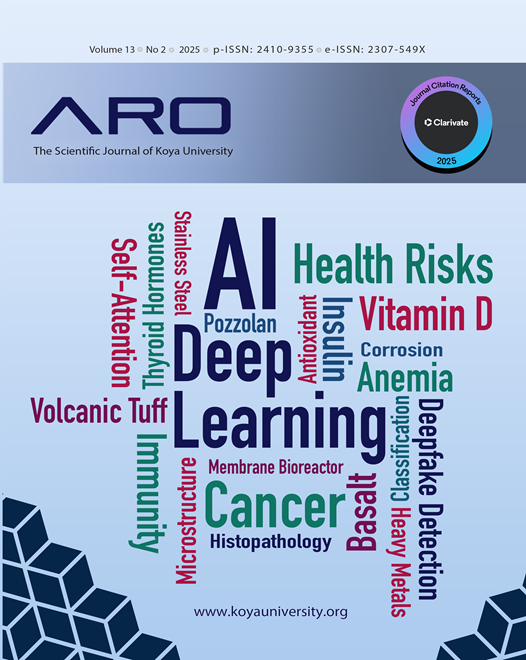Impact of Cement Kiln Dust on Soil Geotechnical Properties
A Case Study of Soils Surrounding Cement Factories in Bazian Area, Sulaimani Governorate, Iraq
DOI:
https://doi.org/10.14500/aro.11961Keywords:
Cement kiln dust, Eco-friendly additive, Soil stabilizer, Swelling, Uniaxial compressive strengthAbstract
As cement demand rises daily; kiln dust from cement-producing facilities is being collected in large quantities. This tiny dust poses a risk to the environment when it is disposed of. This study investigates the potential reuse of CKD as a stabilizing agent for expansive soils. The amount of CKD added to intact soil was 0%, 10%, 20%, 30%, and 40% of the dry mass of the soil. The liquid limit (LL) of the intact soil decreased after adding CKD from 47.7% to 43.7%, and the plastic limit (PL) from 26.97% decreased to 21.36%. A sharp decrease was observed in the consistency index (Ic) and toughness index (It), while the flow index (If), liquidity index (Li) and shrinkage index (Is) are noticeably increased. The unconfined compressive strength (qu), modulus of elasticity (E), and Resilient Modulus (Ur) increased for the samples cured for 7 days and 28 days; the rate of increase in the values of these parameters was observed to be higher in 28 days during the period compared to 7 days. Also, the shear strength and cohesion sharply increased after the soil was treated with CKD. The UPV also increased for both sets of prepared cylindrical soil samples. The CKD additives decreased the hydraulic conductivity of the soil and successfully improved the geotechnical characteristics of fine-grained soil. Thus, CKD can be repurposed as a sustainable soil stabilizer for slopes, subgrades, and foundations, providing a viable solution for its disposal and reducing environmental impact.
Downloads
References
Ahmed, Z.J., Jafer, H., and Al-Kremy, A.R.A., 2024. Investigating the impact of ground granulated blast furnace slag (GGBS) and cement kiln dust (CKD) on fine grained soil subgrade in Al Hillah city. IOP Conference Series Earth and Environmental Science. 1374, p.012016. DOI: https://doi.org/10.1088/1755-1315/1374/1/012016
Al-Bakri, A.Y., Ahmed, H.M., and Hefni, M.A., 2024. Experimental investigation of recycling cement kiln dust (CKD) as a co-binder material in cemented paste backfill (CPB) made with copper tailings. Minerals, 14(8), p.750. DOI: https://doi.org/10.3390/min14080750
Al-Homidy, A.A., Dahim, M.H., and Abd El Aal, A.K., 2017. Improvement of geotechnical properties of sabkha soil utilizing cement kiln dust. Journal of Rock Mechanics Geotechnical Engineering, 9, p. 749-760. DOI: https://doi.org/10.1016/j.jrmge.2016.11.012
Al-Rubaiee, A.K.H., and Hussian, M.L., 2022. Effect of adding cement dust waste on the geotechnical properties behavior of selected gypseous soil in Al-Najaf city. The Iraqi Geological Journal, 55, pp.165-181. DOI: https://doi.org/10.46717/igj.55.2A.12Ms-2022-07-28
Amadi, A.A., and Eberemu, A.O., 2013. Potential application of lateritic soil stabilized with cement kiln dust (CKD) as liner in waste containment structures. Geotechnical and Geological Engineering, 31, pp.1221-1230. DOI: https://doi.org/10.1007/s10706-013-9645-3
Amadi, A.A., and Lubem, S., 2014. Assessing stabilization effectiveness of combined cement kiln dust and quarry fines on pavement subgrades dominated by black cotton soil. Geotechnical and Geological Engineering, 32, pp.1231-1238. DOI: https://doi.org/10.1007/s10706-014-9793-0
ASTM, D698, 2021. Standard Test Methods for Laboratory Compaction Characteristics of Soil Using Standard Effort (12,400 ft-lbf/ft3 (600 kN-m/m3)).
ASTM, D2166, 2010. Standard Test Method for Unconfined Compressive Strength of Cohesive Soil.
ASTM, D4318-10, 2014. Standard test methods for liquid limit, plastic limit, and plasticity index of soils.
Arulrajah, A., Mohammadinia, A., D’Amico, A., and Horpibulsuk, S., 2017. Effect of lime kiln dust as an alternative binder in the stabilization of construction and demolition materials. Construction and Building Materials, 152, pp.999-1007. DOI: https://doi.org/10.1016/j.conbuildmat.2017.07.070
Bolt, G., Bruggenwert, M., and Kamphorst, A., 1976. Adsorption of cations by soil. In: Developments in Soil Science. Elsevier, Netherlands, pp54-90. DOI: https://doi.org/10.1016/S0166-2481(08)70633-0
Buday, T., 1980. The regional geology of Iraq: stratigraphy and paleogeography (Vol.1). State Organization for Minerals, Directorate General for Geological Survey and Mineral Investigations.
Buringh, P., 1960. Soils and Soil Conditions in Iraq. Available from: https://edepot.wur.nl/480098 [Last accessed on 2024 Oct 06].
Bye, G.C., 1999. Portland Cement: Composition, Production and Properties.Thomas Telford, England.
Cement Kiln Dust Report to Congress.; 1993. Special Wastes. US EPA, UnitedStates. Available from: https://archive.epa.gov/epawaste/nonhaz/ industrial/special/web/html/cement2.html [Last accessed on 2025 Jun 09].
Ashwini, D., and Ramesh, H.N., 2023. Effect of lime and cement kiln dust on strength characteristics of expansive soil. Geotechnical Engineering Journal of the SEAGS and AGSSEA, 54, p.12.
Elbaz, A.A., Aboulfotoh, A.M., Dohdoh, A.M., and Wahba, A.M., 2019. Review of beneficial uses of cement kiln dust (CKD), fly ash (FA) and their mixture. Journal Materials Environmental Science, 10(11), pp.1062-1073.
Gilbert, A., 2025. Investigating the effectiveness of cement kiln dust as an expansive soil stabilizer in road construction. International Journal of Research and Innovation in Social Science, 9(1), pp.1401-1412. DOI: https://doi.org/10.47772/IJRISS.2025.9010117
Gupta, R.K., Majumdar, D., Trivedi, J.V., and Bhanarkar, A.D., 2012. Particulate matter and elemental emissions from a cement kiln. Fuel Processing Technology, 104, pp.343-351. DOI: https://doi.org/10.1016/j.fuproc.2012.06.007
Habert, G., 2014. Assessing the environmental impact of conventional and ‘green’ cement production. In: Eco-Efficient Construction and Building Materials. Elsevier, Netherlands, pp.199–238. Available from: https://www. sciencedirect.com/science/article/pii/B9780857097675500108 [Last accessed on 2024 Dec 09]. DOI: https://doi.org/10.1533/9780857097729.2.199
Huntzinger, D.N., and Eatmon, T.D., 2009. A life-cycle assessment of Portland cement manufacturing: Comparing the traditional process with alternative technologies. Journal of Cleaner Production, 17(7), pp.668-675. DOI: https://doi.org/10.1016/j.jclepro.2008.04.007
Ismaiel, H.A., 2013. Cement kiln dust chemical stabilization of expansive soil exposed at El-Kawther Quarter, Sohag Region, Egypt. International Journal of Geosciences, 4, p.1416-1424. DOI: https://doi.org/10.4236/ijg.2013.410139
Jassim, S.Z. and Goff, J.C., 2006. Geology of Iraq. DOLIN, s.r.o., Prague, Czech Republic; distributed by the Geological Society of London, UK.
Kumar, Anil, and A. K. Singh., (2017). Stabilization of soil using cement kiln dust. International Journal of Innovative Research in Science, Engineering and Technology 6, no. 6 p.11631-11637.
Miller, G.A., and Azad, S., 2000. Influence of soil type on stabilization with cement kiln dust. Construction and Building Materials, 14(2), pp.89-97. DOI: https://doi.org/10.1016/S0950-0618(00)00007-6
Miller, G.A., and Zaman, M., 2000. Field and laboratory evaluation of cement kiln dust as a soil stabilizer. Transportation Research Record Journal of the Transportation Research Board, 1714(1), pp.25-32. DOI: https://doi.org/10.3141/1714-04
Mohammed, O.H., and Al-Hazaa, S.H., 2025. Evaluation of clay deposits for the manufacture of bricks in the Bazian basin, northern Iraq. Samarra Journal of Pure and Applied Science, 7(1), pp.310-328.
Peethamparan, S., and Olek, J., 2008a. Study of the effectiveness of cement kiln dusts in stabilizing Na-montmorillonite clay. Journal of Materials in Civil Engineering, 20(2), pp.137-146.
Peethamparan, S., and Olek, J., 2008b. Study of the effectiveness of cement kiln dusts in stabilizing Na-Montmorillonite clay. Journal of Materials in Civil Engineering, 20(2), pp.137-146. DOI: https://doi.org/10.1061/(ASCE)0899-1561(2008)20:2(137)
Reid, H., 2024. The Science and Art of the Manufacture of Portland Cement. BoD-Books on Demand, Germany.
Rimal, S., Poudel, R.K., and Gautam, D., 2019. Experimental study on properties of natural soils treated with cement kiln dust. Case Studies in Construction Materials, 10, e00223. DOI: https://doi.org/10.1016/j.cscm.2019.e00223
Sherwany, J.H., Kakrasul, J.I., and Han, J., 2023. Effect of waste glass on properties of treated problematic soils. Aro-The Scientific Journal of Koya University, 11(2), pp.180-190. DOI: https://doi.org/10.14500/aro.11284
Sreekrishnavilasam, A., Rahardja, S., Kmetz, R., and Santagata, M., 2007. Soil treatment using fresh and landfilled cement kiln dust. Construction and Building Materials, 21(2), pp.318-327. DOI: https://doi.org/10.1016/j.conbuildmat.2005.08.015
Yamagoshi, Y., Kitano, Y., Kosugi, C., Nakagawa, M., Akashi, Y., Kiso, E., Miki, O., and Hata, K., 2015. Basic characteristics of CaO-improved soil. Nippon Steel and Sumitomo Metal Technical Report, 109, pp.51-58.
Yin, C., Deng, S., Zhao, J., Tao, Y., and Huang, J., 2025. Effects of non-traditional additives on the early strength of a lean clay soil stabilized by compound calcium-based stabilizer. Periodica Polytechnica Civil Engineering, 64(2). DOI: https://doi.org/10.3311/PPci.37150
Zhao, Y., Gao, J., Liu, C., Chen, X., and Xu, Z., 2020. The particle-size effect of waste clay brick powder on its pozzolanic activity and properties of blended cement. Journal of Cleaner Production, 242, p.118521. DOI: https://doi.org/10.1016/j.jclepro.2019.118521
Downloads
Published
How to Cite
Issue
Section
License
Copyright (c) 2025 Rozhgar A. Hasan , Fahmy O. Mohammed, Nihad B. Salih

This work is licensed under a Creative Commons Attribution-NonCommercial-ShareAlike 4.0 International License.
Authors who choose to publish their work with Aro agree to the following terms:
-
Authors retain the copyright to their work and grant the journal the right of first publication. The work is simultaneously licensed under a Creative Commons Attribution License [CC BY-NC-SA 4.0]. This license allows others to share the work with an acknowledgement of the work's authorship and initial publication in this journal.
-
Authors have the freedom to enter into separate agreements for the non-exclusive distribution of the journal's published version of the work. This includes options such as posting it to an institutional repository or publishing it in a book, as long as proper acknowledgement is given to its initial publication in this journal.
-
Authors are encouraged to share and post their work online, including in institutional repositories or on their personal websites, both prior to and during the submission process. This practice can lead to productive exchanges and increase the visibility and citation of the published work.
By agreeing to these terms, authors acknowledge the importance of open access and the benefits it brings to the scholarly community.
Accepted 2025-07-02
Published 2025-07-28
















 ARO Journal is a scientific, peer-reviewed, periodical, and diamond OAJ that has no APC or ASC.
ARO Journal is a scientific, peer-reviewed, periodical, and diamond OAJ that has no APC or ASC.